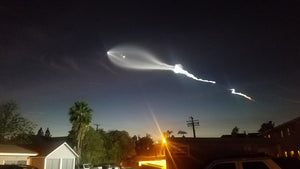Worldwide Space Schedule
Worldwide Space Schedule
Via Space.comOct. 5: A Russian Soyuz rocket will launch the Soyuz MS-19 crew capsule to the International Space Station with Russian cosmonaut Anton Shkaplerov and two Russian space tourists: film director Klim Shipenko and actress Yulia Peresild, who plan to film a movie while spending 12 days in space. It will lift off from the Baikonur Cosmodrome in Kazakhstan at 4:55 a.m. EDT
Oct. 6: The new moon arrives at 7:05 a.m. EDT
Oct. 8: The Draconid meteor shower, which is active Oct. 6-10, will peak overnight.
Oct. 9: Conjunction of the moon and Venus. The waxing crescent moon will pass about 3 degrees to the north of Venus. Look for the pair above the western horizon after sunset.
Oct. 14: A Soyuz rocket will launch 36 satellites into orbit for the OneWeb internet constellation. The mission, called OneWeb 11, will lift off from the Vostochny Cosmodrome in Russia.
Oct. 14: Conjunction of the moon and Saturn. The waxing gibbous moon will swing about 4 degrees to the south of Saturn in the evening sky.
Oct. 15: Conjunction of the moon and Jupiter. The waxing gibbous moon will swing about 4 degrees to the south of Jupiter in the evening sky.
Oct. 16: NASA will launch its Lucy mission to study the Trojan asteroids. It will lift off from Space Launch Complex-41 at Cape Canaveral Space Force Station in Florida at 5:34 a.m. EDT (0934 GMT), on a United Launch Alliance Atlas V rocket.
Oct. 16/17: The Soyuz MS-18 crew capsule will return to Earth from the International Space Station with Russian cosmonaut Oleg Novitsky, as well as two space tourists: Russian film director Klim Shipenko and a (not-yet-named) Russian actress, who will have arrived on the Soyuz MS-19 mission in September and plan to film a movie in space. Undocking is scheduled for 9:13 p.m. EDT on Oct. 16 (0113 Oct. 17 GMT), and the crew will land in Kazakhstan at approximately 12:36 a.m. (0436 GMT) on Oct. 17.
Oct. 20: The full moon of October, known as the Full Hunter's Moon, occurs at 10:57 a.m. EDT
Oct. 21: The waning gibbous moon and Uranus will make a close approach, passing within 1.3 degrees of each other. Shining at magnitude 5.7, Uranus may be bright enough to spot with the naked eye under dark skies.
Oct. 21: South Korea will launch its new Korea Space Launch Vehicle 2 (KSLV-2) rocket, called Nuri, on its first orbital launch attempt from the Naro Space Center, carrying a dummy payload.
Oct. 21-22: The annual Orionid meteor shower, which is active all month long, peaks overnight.
Oct. 22: Arianespace will use an Ariane 5 ECA rocket to launch the SES 17 and Syracuse 4A communications satellites from the Guiana Space Center near Kourou, French Guiana.
Oct. 24: Mercury at greatest elongation west. The innermost planet will reach its greatest western separation from the sun, shining brightly at magnitude -0.6. Catch the elusive planet above the eastern horizon shortly before sunrise. The following day (Oct. 25) Mercury will reach its highest point in the morning sky.
Oct. 24: The Japan Aerospace Exploration Agency (JAXA) will use an H-2A rocket to launch a replacement satellite for the country's Quasi-Zenith Satellite System, a regional GPS system. Dubbed QZS 1R, the satellite will lift off from the Tanegashima Space Center during a one-hour launch window that opens at 10 p.m. EDT
Oct. 28: A Russian Soyuz rocket will launch the Progress 79 cargo resupply spacecraft to the International Space Station. It will lift off from the Baikonur Cosmodrome in Kazakhstan.
Oct. 30: A SpaceX Falcon 9 rocket will launch a Crew Dragon spacecraft on the Crew-3 mission, the third operational astronaut flight to the International Space Station. On board will be NASA astronauts Raja Chari and Thomas Marshburn, and European Space Agency astronaut Matthias Maurer. (The fourth crewmember has not yet been announced). It will lift off from Launch Complex 39A at NASA's Kennedy Space Center in Florida.
Also scheduled to launch in October (from Spaceflight Now):
- China will launch three astronauts to the Chinese space station on the Shenzhou 13 mission, which will launch on a Long March 2F rocket from the Jiuquan Satellite Launch Center in the Gobi Desert.
- A SpaceX Falcon Heavy rocket will launch the USSF 44 mission for the U.S. Air Force. The mission will lift off from NASA's Kennedy Space Center in Florida and is expected to deploy two undisclosed payloads into geosynchronous orbit.
- A SpaceX Falcon 9 rocket will launch 51 satellites for the company's Starlink broadband internet constellation. It will lift off from Space Launch Complex 4 at Vandenberg Space Force Station in California.
- Rocket Lab will use an Electron rocket to launch two Earth observation satellites for the Seattle-based company BlackSky Global's planned constellation. The mission, nicknamed "Love At First Insight," will lift off from the Mahia Peninsula in New Zealand. This will be the first in a rapid succession of three BlackSky launches by Rocket Lab scheduled to launch no earlier than October.







